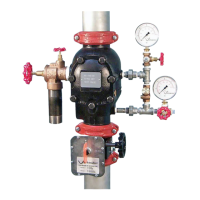WATER FLOW ALARM TEST
Perform the water flow alarm test on a frequency required by national
standards. In addition, the authority having jurisdiction in the area may
require these tests on a more frequent basis. Verify these requirements
by contacting the authority having jurisdiction in the affected area.
1. Notify the authority having jurisdiction, remote station alarm moni-
tors, and anyone in the affected area that the water flow alarm test
will be performed.
2. Verify that the alarm line ball valve (11) is open.
3. Open the system test valve (13) fully, as shown above. Confirm that
mechanical and electrical alarms are activated and that remote
monitoring stations, if provided, receive an alarm signal. NOTE:
There may be a time delay if a Series 752 VdS Retarding Chamber
Assembly (9) is installed.
4. Close the system test valve (13) after proper operation of all alarms
is verified.
5. Verify that all alarms stopped sounding, that the alarm line drained
properly, and that remote station alarms reset properly.
6. Push in the plunger of the restricted orifice/alarm line drain (7), as
shown above.
6a. Verify that water is not flowing from the restricted ori-
fice/alarm line drain (7). If water is flowing, refer to the
"Troubleshooting" section.
7. Notify the authority having jurisdiction, remote station alarm moni-
tors, and those in the affected area that the valve is back in ser-
vice.
8. Provide test results to the authority having jurisdiction, if required.
I-751.VDS / Series 751 FireLock
™
European Alarm Check Valve Stations / Installation, Maintenance, and Testing Manual
I-751.VDS_12 REV_F

